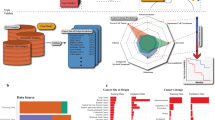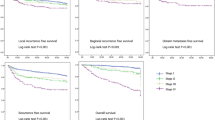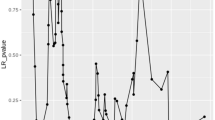Summary
Forty-eight primary oral squamous cell carcinomas (SCC) were screened for allelic imbalance (AI) at 3p24–26, 3p21, 3p13, 8p21–23, 9p21, 9q22 and within the Rb, p53 and DCC tumour suppressor genes. AI was detected at all TNM stages with stage 4 tumours showing significantly more aberrations than stage 1–3. A factional allelic loss (FAL) score was calculated for all tumours and a high score was associated with development of local recurrence (P = 0.033) and reduced survival (P = 0.0006). AI at one or more loci within the 3p24–26, 3p21, 3p13 and 9p21 regions or within the THRB and DCC genes was associated with reduced survival. The hazard ratios for survival analysis revealed that patients with AI at 3p24–26, 3p13 and 9p21 have an approximately 25 times increase in their mortality rate relative to a patient retaining heterozygosity at these loci. AI at specific pairs of loci, D3S686 and D9S171 and involving at least two of D3S1296, DCC and D9S43, was a better predictor of prognosis than the FAL score or TNM stage. These data suggest that it will be possible to develop a molecular staging system which will be a better predict of outcome than conventional clinicopathological features as the molecular events represent fundamental biological characteristics of each tumour.
Similar content being viewed by others
Article PDF
Change history
16 November 2011
This paper was modified 12 months after initial publication to switch to Creative Commons licence terms, as noted at publication
References
Ah-See, K. W., Cooke, T. G., Pickford, I. R., Soutar, D. & Balmain, A. (1994). An allelotype of squamous carcinoma of the head and neck using microsatellite markers. Cancer Res 54: 1617–1621.
Anneroth, G., Batsakis, J. & Luna, M. (1987). Review of the literature and a recommended system of malignancy grading in oral squamous cell carcinomas. Scand J Dental Res 95: 229–249.
Brennan, J. A., Boyle, J. O., Koch, W., Goodman, S. N., Hruban, R. H., Eby, Y. J., Couch, M. J., Forastiere, A. A. & Sidransky, D. (1995). Association between cigarette smoking and mutation of the p53 gene in squamous cell carcinoma of the head and neck. N Engl J Med 332: 712–717.
Califarno, J., van der Reit, P., Westra, W., Nawroz, H., Clayman, G., Piantadosi, S., Corio, R., Lee, D., Greenberg, B., Koch, W. & Sidransky, D. (1996). Genetic progression model for head and neck cancer: implications for field cancerisation. Cancer Res 56: 2488–2492.
Cairns, P., Polascik, T. J., Eby, Y., Tokino, K., Califarno, J., Merlo, A., Mao, L., Herath, J., Jenkins, R., Westra, W., Rutter, J. L., Bucker, A., Gabrielson, E., Tockman, M., Cho, K. R., Hedrick, L., Bova, G. S., Isaacs, W., Koch, W., Schwab, D. & Sidransky, D. (1995). Frequency of homozygous deletion at p16/CDKN2 in primary human tumours. Nature Genet 11: 210–212.
Cox, D. R. (1972). Regression models and life tables (with discussion). J Roy Stat Soc B 34: 187–220.
El-Naggar, A. K., Lee, M. S., Wang, G., Luna, M. A., Goepfert, H. & Batsakis, J. G. (1993). Polymerase chain reaction-based restriction length polymorphism analysis of the short arm of chromosome 3 in primary head and neck squamous cell carcinoma. Cancer 72: 881–886.
El-Naggar, A. K., Hurr, K., Batsakis, J. G., Luna, M. A., Goepfert, H. & Huff, V. (1995). Sequential loss of heterozygosity at microsatellite motifs in preinvasive head and neck squamous carcinoma. Cancer Res 55: 2656–2659.
Field, J. K., Tsiiriytos, C. & Zoumpourlis, V. (1994). Allele loss on chromosome 3 in squamous cell carcinoma of the head and neck correlates with poor clinical prognostic indicators. Int J Oncol 4: 543–549.
Field, J. K., Kiaris, H., Tsiriyotis, C., Adamson, R., Zoumpourlis, V., Rowley, H., Taylor, K., Whittaker, J., Howard, P., Beirne, J. C., Gosney, J. R., Woolgar, J., Vaughan, E. D., Spandidos, D. A. & Jones, A. S. (1995). Allelotype of squamous cell carcinoma of the head and neck: fractional allelic loss correlated with survival. Br J Cancer 72: 1180–1188.
Frank, C. J., McClatchey, K. D., Davaney, K. O. & Carey, T. E. (1997). Evidence that loss of chromosome 18q is associated with tumour progression. Cancer Res 57: 824–827.
Hermanek, P. & Sobin, L. (1987). UICC TNM Classification of Malignant Tumours, 3rd edn. Spinger-Verlag: Berlin
Ishwad, C. S., Ferrell, R. E., Rossie, K. M., Appel, B. N., Johnson, J. T. & Myers, E. N. (1996). Loss of heterozygosity of the short arm of chromosomes 3 and 9 in oral cancer. Int J Cancer 69: 1–4.
Jones, P. A. & Buckley, T. D. (1990). The role of DNA methylation in cancer. Adv Cancer Res 54: 1–23.
Kelker, W., van Dyke, D. L., Worsham, M., Christopherson, P. L., James, C. D., Conlon, M. R. & Carey, T. E. (1996). Loss of 18 and homozygosity for the DCC locus: possible markers for clinically aggressive squamous cell carcinoma. Anticancer Res 16: 2363–2371.
Kemp, C. J., Donehower, L. A., Bradley, A. & Balmain, A. (1993). Reduction of p53 gene dosage does not increase initiation or promotion but enhances malignant progression of chemically induced skin tumours. Cell 74: 813–822.
Kerangueven, F., Toguchida, T., Coulier, F., Allione, F., Wargniez, V., Simony-Lafontaine, J., Longy, M., Jacquemier, J., Sobol, H., Eisinger, F. & Birnbaum, D. (1997). Genome-wide search for loss of heterozygosity shows extensive genetic diversity of human breast carcinomas. Cancer Res 57: 5469–5474.
Kiaris, H., Jones, A. S., Spandidos, D. A., Vaughan, E. D. & Field, J. K. (1994). Loss of heterozygosity on chromosome 8 in squamous cell carcinomas of the head and neck. Int J Oncol 5: 1243–1248.
Kim, S. K., Fan, Y., Papadimitrakopoulou, V., Clayman, G., Hittelman, W. N., Hong WK Lotan, R. & Mao, L. (1996). DPC4, a candidate tumour suppressor gene, is altered infrequently in head and neck squamous cell carcinoma. Cancer Res 56: 2519–2521.
Kim, S. K., Ro, J. Y., Kemp, B. L., Lee, S. J., Kwoon, T. J., Fong, K. M., Sekido, Y., Minna, J. D., Hong, W. K. & Mao, L. (1997). Identification of three distinct tumour suppressor gene loci on the short arm of chromosome 9 in small cell lung cancer. Cancer Res 52: 400–403.
Langdon, J. D. & Henk, J. M. (1995). Classification and staging. In Malignant Tumours of the Mouth, Jaws and Salivary Glands, Langdon JD and Henk JM (eds), pp. 36–49. Edward Arnold: London
Largey, J. S., Meltzer, S. J., Yin, J., Norris, K., Sauk, J. J. & Archibald, D. W. (1993). Loss of heterozygosity of p53 in oral cancers demonstrated by the polymerase chain reaction. Cancer 71: 1933–1937.
Lee, D. L., Koch, W. M., Yoo, G., Lango, M., Reed, A., Califarno, J., Brennan, J. A., Westra, W. H., Zahurak, M. & Sidransky, D. (1997). Impact of chromosome 14q loss on survival in primary head and neck squamous cell carcinoma. Clin Cancer Res 3: 501–505.
Lee, N. K., Ye, Y. W., Li, X., Schweitzer, C. & Nisen, P. D. (1994). Allelic loss on chromosome 13 can proceed histological changes in head and neck cancer. Int J Oncol 5: 205–210.
Li, Y-Q, Pavelic, Z. P., Wang, L-J, McDonald, J. S., Gleich, L., Munck-Wikland, E., Dacic, S., Danilovic, Z., Pavelic, L. J., Wilson, K. M., Gluckman, J. L. & Stambrook, P. J. (1995). Altered p53 in microdissected, metachronous, premalignant and malignant oral lesions from the same patients. J Clin Pathol (Clin Mol Pathol) 48: M269–M272.
Lydiatt, W. M., Davidson, B. J., Schantz, S. P., Caruana, S. & Chaganti, R. S. K. (1998). 9p21 deletion correlates with recurrence in head and neck cancer. Head Neck 20: 113–118.
Maestro, R., Piccinin, S., Doglioni, C., Gasparotto, D., Vukosavljevic, G., Sulfaro, S., Barzan, L. & Boiocchi, M. (1996). Chromosome 13q deletion mapping in head and neck squamous cell carcinomas: identification of two distinct regions of preferential loss. Cancer Res 56: 1146–1150.
Mao, L., Fan, J. S., Ro, J. Y., Batsakis, J. G., Lippman, S., Hittelman, W. & Hong, W. K. (1996). Frequent microsatellite alterations at chromosomes 9p21 and 3p14 in oral premalignant lesions and their value in cancer risk assessment. Nature Med 2: 682–685.
Min, B. M., Baek, J. H., Shin, K. H., Gujuluva, C. N., Cherrick, H. M. & Park, N. H. (1994). Inactivation of the p53 gene by either mutation of HPV infection is extremely frequent in human oral squamous cell carcinoma cell lines. Eur J Cancer B Oral Oncology 5: 338–435.
Nawroz, H., van der Reit, P., Hruban, R. H., Koch, W., Rupert, J. M. & Sidransky, D. (1994). Allelotype of head and neck squamous cal carcinoma. Cancer Res 54: 1152–1155.
Neville, E. M., Stewart, M., Myskow, M., Donnelly, R. J. & Field, J. K. (1995). Loss of heterozygosity at 9p23 defines a novel locus in non small cell lung cancer. Oncogene 11: 581–585.
Nylander, K., Schildt, E. B., Eriksson, M., Magnusson, A., Mehle, C. & Roos, G. (1996). A non-random deletion in the p53 gene in oral squamous cell carcinoma. Br J Cancer 73: 1381–1386.
Partridge, M., Kiguwa, S. & Langdon, J. D. (1994). Frequent deletion of chromosome 3p in oral squamous cell carcinoma. Eur J Cancer B Oral Oncol 30B: 248–251.
Partridge, M., Emilion, G. & Langdon, J. D. (1996). LOH at 3p correlates with a poor survival in oral squamous cell carcinoma. Br J Cancer 73: 366–371.
Rowley, H., Jones, A. S. & Field, J. K. (1995). Chromosome 18: a possible site for a tumour suppressor gene deletion in squamous cell carcinoma of the head and neck. Clin Otolaryngol 20: 266–277.
Sekido, Y., Lader, S., Latif, F., Chen, J-Y, Duh, F-M, Wei, M-H, Albanesi, J. P., Lee, C-C, Lerman, M. I. & Minna, J. D. (1996). Human semaphorins A(v) and IV reside in the 3p21.3 small cell lung cancer deletion region and demonstrate distinct expression patterns. Proc Natl Acad Sci USA 93: 4120–4125.
Spiro, R. H., Huvos, A. G., Wong, G. Y., Spiro, J. D., Gnecco, C. A. & Strong, E. W. (1986). Predictive thickness in squamous carcinoma confined to the tongue and floor of mouth. Am J Surg 152: 345–350.
Tobe, T. & Ishizaki, K. (1993). Loss of 17p, mutation of the p53 gene, and overexpression of the p53 protein in oesophageal squamous cell carcinoma. Cancer Res 53: 846–850.
Todd, S., Franklin, W. A., Varella-Garcia, M., Kennedy, T., Hiliker, C. E., Hahner, L., Anderson, M., Weist, J. S., Drabkin, H. A. & Gemmil, R. M. (1997). Homozygous deletions of human chromosome 3p in lung tumours. Cancer Res 57: 1344–1352.
van der Reit, P., Nawroz, H., Hruban, R. H., Corio, R., Tokino, K., Koch, W. & Sidransky, D. (1994). Frequent loss of chromosome 9p21–22 in head and neck cancer progression. Cancer Res 54: 1156–1158.
van Dyke, D. L., Worsham, M. J., Benninger, M. S., Krause, C. J., Baker, S. R., Wolf, G. T., Drumheller, T., Tilley, B. C. & Carey, T. E. (1994). Recurrent cytogenetic abnormalities in squamous cell carcinomas of the head and neck region. Genes Chromosom Cancer: 9: 192–206.
Vogelstein, B., Fearnon, E. R., Kern, S., Hamilton, S. R., Preisinger, A. C., Nakamura, Y. & White, R. (1989). Allelotype of colorectal carcinomas. Science 244: 207–211.
Wagata, T., Shibagaki, I., Imamura, M., Shimada, Y., Toguchida, J., Yandell, D. W., Ikenaga, M., Wistuba, I. I., Montellano, F. D. & Milchgrub, S. (1993). Deletions of chromosome 3p are frequent early events in the pathogenesis of uterine cervical carcinoma. Cancer Res 57: 3154–3158.
Weist, J. S., Franklin, J. T., Otstot, J. T., Forbey, K., Varella-Gracia, M., Rao, K., Drabkin, H., Gemmil, R., Ahrendt, S., Sidransky, D., Saccomanno, G., Fountain, J. W. & Anderson, W. W. (1997). Identification of a novel region of homozygous deletion on chromosome 9p in squamous cell carcinoma of the lung: the location of a putative tumour suppressor gene. Cancer Res 57: 1–6.
Wu, C. L., Sloan, P., Read, A. P., Harris, R. H. & Thakkar, N. S. (1994). Deletion mapping on the short arm of chromosome 3 in oral squamous cell carcinoma of the oral cavity. Cancer Res 54: 6484–6488.
Author information
Authors and Affiliations
Rights and permissions
From twelve months after its original publication, this work is licensed under the Creative Commons Attribution-NonCommercial-Share Alike 3.0 Unported License. To view a copy of this license, visit http://creativecommons.org/licenses/by-nc-sa/3.0/
About this article
Cite this article
Partridge, M., Emilion, G., Pateromichelakis, S. et al. The prognostic significance of allelic imbalance at key chromosomal loci in oral cancer. Br J Cancer 79, 1821–1827 (1999). https://doi.org/10.1038/sj.bjc.6990290
Received:
Revised:
Accepted:
Published:
Issue date:
DOI: https://doi.org/10.1038/sj.bjc.6990290
Keywords
This article is cited by
-
Multi-tiered genomic analysis of head and neck cancer ties TP53 mutation to 3p loss
Nature Genetics (2014)



